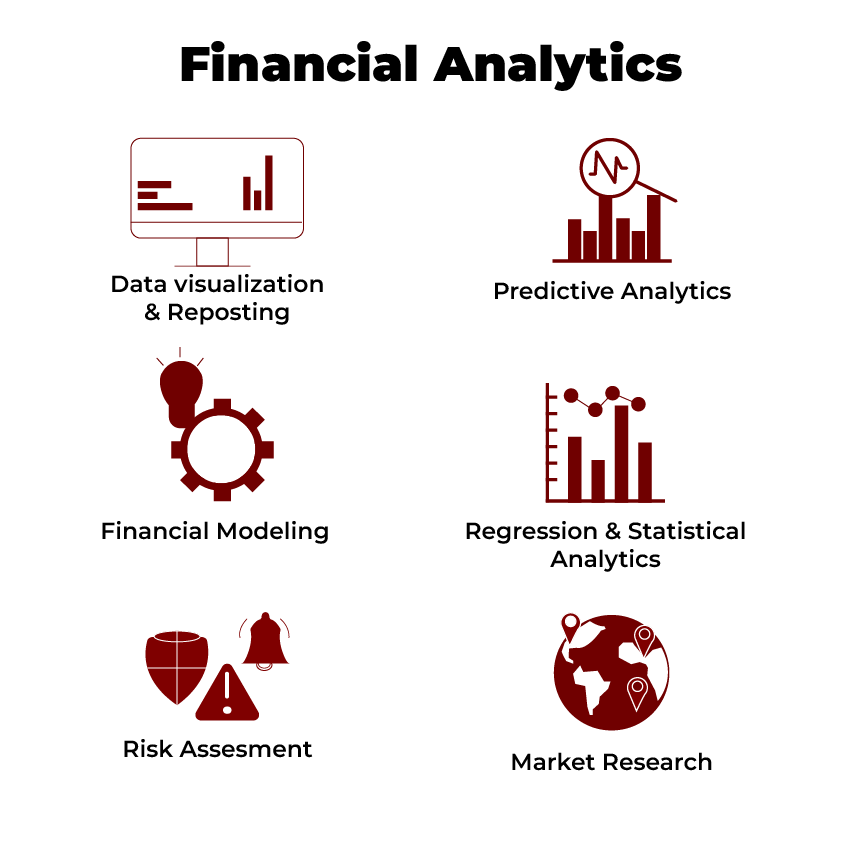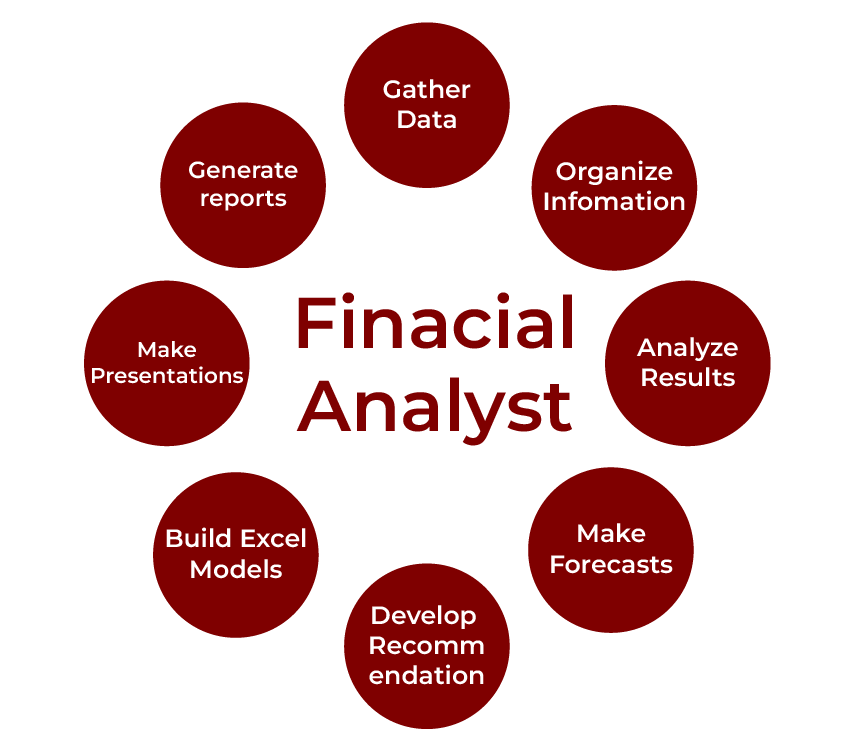Today, businesses are under immense pressure to make reactive as well as predictive decisions. With economic uncertainty, global competition, and rapid technological changes, accurate financial insights have become critical- no longer optional.
This is the point where financial analytics really comes into action. It is more than manipulating figures; rather, it deals with extracting and exposing actionable insights embedded within financial data. These insights thereby drive decision-making on profitability, risk-minimising, and long-term strategic direction.
From finance to health care to retail, financial analytics has made it possible for organisations in every industry to act on smarter decisions quickly.
Financial analytics raised many questions for both businesses and people. How would you interpret and understand great mountains of financial data? What tools are available to help forecast performance in the future? And how is it going to change the ways in which an organisation operates?
Let’s tackle these questions.

What is Financial Analytics?
It is the analysis of financial information to enable actionable recommendations that will allow a business to make forecasts about possible outcomes, assess risk, and generate performance improvement in the future based on that knowledge.
Financial analytics is devoted to the future rather than focusing solely on past reports. It uses sophisticated tools and techniques to enhance revenue forecasts, evaluate risks, and optimise returns on investments.
Key areas where financial analytics plays a vital role include:
Revenue Forecasting
- Predicting future income streams based on past trends and current conditions.
Risk Analysis
- Identifying vulnerabilities and planning strategies to mitigate them.
Profitability Analysis
- Determining which areas of a business are generating the most value.

POSTGRADUATE PROGRAM IN
Financial Analysis, Valuation, & Risk Management
Learn financial modeling, valuation techniques, and risk management to drive strategic business decisions.
What is the Difference Between Financial Analysis and Financial Analytics?
While the terms sound similar, financial analysis and financial analytics serve different purposes.
Let’s see an example of the banking sector. Financial analysis might assess a bank’s performance in the last quarter. Financial analytics, on the other hand, will predict customer behaviour to refine loan strategies for the coming months.
Understanding this distinction helps businesses align their strategies with the right tools and methods.
| Aspect | Financial Analysis | Financial Analytics |
| Focus | Historical performance | Future outcomes and predictions |
| Purpose | Evaluate past results | Improve decision-making for the future |
| Tools | Spreadsheets, financial ratios | AI, machine learning, dashboards |
| Output | Financial reports, ratio analysis | Forecasts, risk assessments, actionable insights |
Why Study Financial Analytics?
The demand for financial analytics skills is surging. Organisations are looking for professionals who can interpret data, anticipate trends, and provide strategies to stay ahead of the curve.
Here’s why learning financial analytics matters:
- Drive Data-Driven Decisions
- Financial analytics helps transform raw data into insights.
- Now, businesses rely on data to make smarter decisions.
- Boost Career Opportunities
- From financial analysts to data scientists, the career paths in financial analytics are diverse and rewarding.
- Salaries in this field often exceed industry averages, with room for rapid growth.
- Stay Competitive
- Businesses need to predict market trends to stay relevant in the market.
- Financial analytics provides the tools and techniques to stay ahead of competitors.
What is the Scope of Financial Analytics?
The scope of financial analytics is vast, touching nearly every aspect of business operations and decision-making. Financial analytics can track trends, estimate outcomes, and thereby optimise an organisation’s financial health.
Here’s where financial analytics makes an impact:
1. Industry Applications
Financial analytics plays a vital role in:
Banking and Finance
- Detecting fraud, improving loan approval processes, and predicting interest rate movements.
Retail
- Analysing sales data to optimise inventory and enhance pricing strategies.
Healthcare
- Managing budgets, reducing operational costs, and forecasting patient demand.
Government
- Improving tax collection efficiency and managing public spending.
2. Types of Analytics Within Financial Analytics
Financial analytics isn’t a one-size-fits-all solution. It includes:
Descriptive Analytics
- Summarises historical data to understand past trends.
Predictive Analytics
- Uses advanced tools to forecast future outcomes, such as revenue projections.
Prescriptive Analytics
- Recommends actions based on data-driven insights, such as investment strategies.
3. Emerging Trends
Innovations are expanding the scope of financial analytics further:
AI and Machine Learning
- Automating processes and refining predictions.
Blockchain Technology
- Bringing about increase transparency and decrease of fraud in financial transactions.
Real-Time Analytics
- Provides real-time insights for businesses to make quicker decisions.

82.9%
of professionals don't believe their degree can help them get ahead at work.
The Role of Financial Data Analytics in Decision-Making
Accurate, timely data is the key to good decision-making. Raw financial data becomes actionable insights in financial data analytics that, in turn, help with strategic moves.
Key Contributions of Financial Data Analytics
Fraud Detection
- They help analyse transaction patterns in order to identify possible anomalies and prevent financial fraud.
Performance Tracking
- Monitoring key financial metrics in real-time to ensure alignment with business goals.
Risk Management
- Anticipating potential risks and planning strategies to mitigate them.
What Does Financial Analytics Do in an Organisation?
In an organisation, financial analytics serves as a tool to improve efficiency, optimise resources, and achieve strategic goals. It connects different parts of the business, making financial data accessible and actionable.
Core Functions of Financial Analytics
Profitability Analysis
- Identifying which products or services bring the most value to the business.
Budget Optimisation
- Ensuring funds are allocated efficiently to maximise returns.
Investment Planning
- Evaluating the profitability of potential ventures or acquisitions.
Real-World Example
For example, Tata Motors leverages financial analytics to streamline its operations and improve profit margins. The company adjusts its strategies to stay competitive by tracking production costs and market demand.
How Does Financial Analytics Work in Practice?
The process behind financial analytics involves several structured steps, each designed to extract maximum value from financial data.

Step-by-Step Process
- Data Collection
- Data is gathered from financial reports, market trends, and customer behaviour.
- Sources may include internal financial statements or external industry benchmarks.
- Data Cleaning
- Raw data often contains errors or inconsistencies.
- Cleaning ensures the data is accurate and ready for analysis.
- Data Analysis
- Techniques like financial modelling and ratio analysis are applied to draw insights.
- Advanced tools such as machine learning algorithms may predict future trends.
- Visualisation and Reporting
- Insights are presented using dashboards and visualisations for easy understanding.
- Tools like Tableau or Power BI are often used to create these visuals.
Who Uses Financial Analytics, and How Do They Benefit?
The versatility of financial analytics makes it valuable to a wide range of industries and professionals.
Industries Benefiting from Financial Analytics
Banking
- Banks use financial analytics to assess credit risks and design profitable loan structures.
Retail
- Retailers optimise inventory and pricing strategies by analysing sales data.
Healthcare
- Hospitals forecast patient demand and manage budgets with greater efficiency.
Professionals Leveraging Financial Analytics
Chief Financial Officers (CFOs)
- Use analytics to monitor financial health and align strategies with business goals.
Portfolio Managers
- Rely on analytics to track investments and maximise returns.
Risk Analysts
- Identify vulnerabilities and develop plans to mitigate risks.
Is Financial Analytics a Good Career Choice?
So, if you pick the path of a career in financial analytics, it will be one of the most intelligent decisions ever. Rapidly growing demand for financial analytics professionals and roles offering wonderful pay and ample long-term growth opportunities.
High Demand Across Industries
Businesses like banking, retail, healthcare, and technology are open to more skilled analysts who help them make data-based financial decisions. Such a demand has many job opportunities.
Lucrative Salaries
Based on data from the industry, financial analytics professionals in India are also getting attractive pay. Entry-level positions begin from about ₹4 – 6 lakhs per annum, but depending on the role, as portfolio managers or CFO, for example, the compensation could be more than ₹30 lakhs.
Diverse Job Roles
A career in financial analytics opens doors to roles like:
- Financial Analyst
- Risk Analyst
- Data Scientist
- Portfolio Manager
Long-Term Growth
With practice, you acquire more experience and get opportunities for more specialised roles or leadership roles. Financial analytics also opens the door to Chief Financial Officer (CFO) positions.
Financial analytics is a career for someone who loves to work with numbers, make decisions, and use new tools.
How Can You Learn Financial Analytics Effectively?
To build expertise in financial analytics, you have to have a combination of formal education, certifications and practical experience.
Here’s how you can get started:
- Formal Education
A finance, economics, or data science degree provides a strong foundation. Courses in statistics, accounting, and financial modelling are particularly useful.
- Certifications
Adding certifications to your portfolio can make you stand out. Some of the most recognised certifications include:
Chartered Financial Analyst (CFA)
- A globally recognised qualification for investment professionals.
Financial Modelling Certifications
- Offered by institutes like the Corporate Finance Institute (CFI).
Data Analytics Courses
- Platforms Hero Vired offer specialised programs combining finance and analytics.
- Hands-On Experience
Practical experience is invaluable. Working with tools like Excel, Tableau, and Python will help you understand real-world applications. Internships or freelance projects in finance can also provide hands-on exposure.
Building skills in financial analytics doesn’t require years of education. A strategic approach combining learning and practice can fast-track your journey.
Key Technologies and Tools Used in Financial Analytics
Mastering the right tools and technologies is crucial for excelling in financial analytics.
Here are the most widely used:
Excel
- Backbone of financial analytics for financial modelling, budgeting, and data analysis.
- Advanced features: PivotTables and macros.
Tableau and Power BI:
- Tools for creating interactive dashboards.
- Ideal for visualising complex financial data.
Python and R:
- Handle large datasets efficiently.
- Automate processes and apply machine learning.
SQL:
- Query and manage databases.
- Retrieve and manipulate financial data with precision.
AI and Machine Learning Platforms:
- Forecast trends and identify risks.
- Widely adopted in sectors like banking and healthcare.
Conclusion
Financial analytics as a tool for translating big raw data into strategic information gives organisations much more space and foresight for predicting future outcomes, mitigating risk, and enhancing the performance of banking, healthcare, and retail industries.
Its utility ranges from profit analysis to fraud detection, and advanced technologies like AI, machine learning, and real-time analytics keep widening its scope. Learning financial analytics will equip one to get high-demand jobs with good salaries and unimaginable progress.
Mastering the key tools, such as Excel, Tableau, and Python, and pursuing certifications, anyone can make use of this dynamic edge to be poised for success in today’s data-driven decisions. Financial analytics is nothing short of building a foundation for the future of informed decision-making.
Are you willing to learn more about financial analytics, an amalgamation of data analytics and business analysis, and open the door to new opportunities? The Accelerator Program in Business Analytics and Data Science by Hero Vired is the best way to start this journey. In addition to theoretical principles, this course includes Python and Tableau with advanced analytics techniques so that you are equipped to shine in the area of finance. If you’re willing to take the next step to get started, then this might be your unlocking point to building a successful career toward data-driven decision-making.
What is financial analytics?
What is the scope of financial analytics in the real world?
Is financial analytics a good career?
Updated on January 27, 2025
